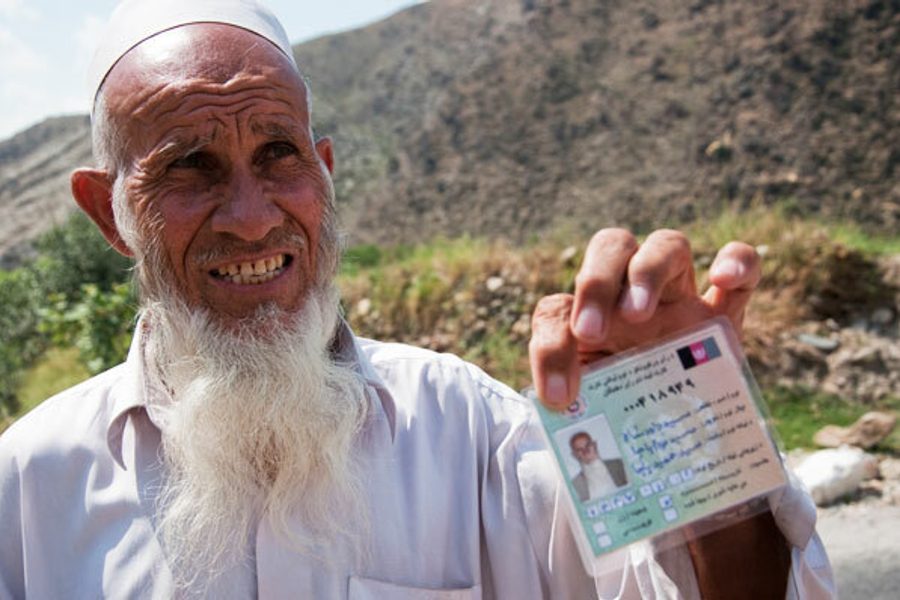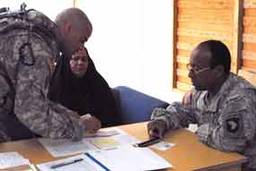Democracy and Action
Afghanistan’s historic August election was marred by widespread voting inconsistencies, despite efforts by U.S. and Afghan soldiers—and warlords—to keep the peace.
James Foley

KUNAR PROVINCE, AFGHANISTAN – As gunshots rang out from the mountain tops of the Dewegal Valley in eastern Afghanistan, men voted under the shade of trees next to their village’s mosque. Heads turned upward whenever a heavy shell or particularly loud burst echoed, but the voters appeared in no hurry to leave. This was supposed to be their election, after all.
But the historic national election, held on August 20, continues to be mired in controversy. As Afghan President Hamid Karzai claims a victory and his main challenger, Dr. Abdullah Abdullah, makes his case that widespread voting fraud necessitates a run-off election, serious doubts remain about whether fair voting was possible in Afghanistan’s insurgent-infested areas.
Election officials said Karzai won 54.1 percent of the vote, while Abdullah received 28.3 percent. But the Electoral Complaints Commission, the United Nations-backed Afghan panel that will certify the final count, is in the early stages of an investigation that could take several weeks.
The international community has found convincing evidence of fraud, especially in the country’s insecure south and east, where the Election Complaints Commission has registered hundreds of claims of vote tampering, ballot stuffing and false registrations. This week the commission threw out votes from 83 polling places and ordered further recounts.
Here in Kunar province, the fact that a polling site was set up in a dangerous valley reveals the conundrum of holding an election in areas beyond official scrutiny.
Amongst the line of men waiting to vote in cardboard booths in the village of Ternaab were young teens holding voter registration cards. By their looks, some of them couldn’t have been eighteen, the minimum voting age. One teenager said he was thirteen, then pulled his registration card from his pocket. It had the same official stamp as the rest of the adults, and verified his age as eighteen.
Two other teenage boys confirmed they were underage and had voted, while many more teens in the crowd proudly displayed inked fingertips. All of them said they were voting for President Hamid Karzai.
This apparent voting fraud was predicted by many non-governmental agencies and think tanks. “Given the failure to steadily tackle legal and organizational flaws and a deteriorating security environment, these elections face grave challenges,” the International Crisis Group (ICG) warned in a late June report.
The report specified how insurgent activity “greatly reduces the likely scrutiny of the poll’s conducted in these areas, increasing opportunities for fraud,” making the presence of permanent election advisers impossible in 14 provinces.
Everyone gets a vote – or three
Considering the difficulty of traversing mountainous terrain, it is understandable that the Afghan Independent Election Commission (IEC) – conducting its first Afghan-controlled election – chose polling sites in remote villages in this region to provide voting access to as many rural people as possible.
But the system also allowed village elders to select local district field coordinators to facilitate “buy-in” among the tribes, according to U.S. Army Lt. Col. Michael J. Forsythe of 2-77th FAR, based at a remote military base in Nuristan province, which neighbors Kunar.
The ICG report stated that the IEC’s permanent staff of 400 would increase to a temporary staff of 165,000 on Election Day, with about 7,000 polling centers around the country. The hiring of so many local, unsupervised field coordinators only increased the opportunities for fraud and patronage voting.
The district field coordinator in Ternaab said he passed a basic literacy and elections test to get his position. But what occurred on election day in the village exemplifies the problems that arise when a village cannot provide security for legitimate election monitors, and when the local police, tribal elders and village-selected field coordinators are complicit in voting irregularities.
The ICG report detailed that there was almost no way to protect against multiple voter card issuance in Afghan provinces. 433,000 voters registered to vote in Nuristan, even though its total population, including those too young to vote, is 130,000.
“As discussed, the IEC has been appointed solely by the president, and its perceived partisanship is a major potential shadow over the legitimacy of the 2009-2010 elections,” the report said.
Election Day firefight
D Company of the 1st -32nd Infantry of the 3rd Battalion, 10th Mountain Division, operates out of Forward Operating Base Fortress in the Kunar river valley. Its area of operations covers the three volatile districts of Nurgal, Chawki and Narang in southern Kunar province.
With the Taliban controlling areas leading higher into the mountains, the smaller valleys are simply too dangerous to regularly patrol. D Company’s command charged them with providing the outer ring of security in Ternaab village on Election Day. They were wary of using the village as an election site.
“The enemy has known fighting positions along ridge lines,” Platoon Leader Captain Richard Nicorvo said.
Before the polling site even opened, Taliban insurgents flooded the area’s radio waves with propaganda about attacking the polling site and killing anyone who attempted to vote.
An hour later the shooting began. Small detachments of Afghan National Army (ANA) soldiers responded with fire from hilltop fighting positions. Their U.S. military counterparts fired a missile and .50 caliber rounds at a mountaintop where they spotted muzzle flashes, following a lengthy communications process to avoid firing on Afghan Army soldiers and hired security groups.
Sporadic fighting continued most of the afternoon, as Toyotas emblazoned with posters of national candidates and packed with Afghan men raced to and from the Ternaab polling site loaded with voters.
The shooting died down by late afternoon, and we approached the polling site. The local IEC head field coordinator told us cameras were not allowed as his colleagues, wearing official IEC vests, began orally tallying the votes from a taped-off area between several trees.
We heard “Karzai, Karzai, Karzai,” as the ballots were stacked and then stuffed into secured plastic boxes. The counting appeared transparent, as far as the villagers were concerned. There was no reason to believe that any votes were lost or uncounted.
A man in a white beard, who said he officially represented Karzai in the province, claimed his job was to verify all votes for the incumbent. When asked about children voting, he said they only looked young and were actually eighteen.
When questioned why other candidates did not have “official verifiers,” he responded they must have been around – but because they lost so badly, they probably left. The man said he tallied over 1,600 votes for Karzai, with just 200 votes for Abdullah.
‘This is an Afghan event’
In contrast to the voting irregularities, the U.S. and the Afghan military maintained security. Although the Taliban promised and delivered a steady payload of fire, both military forces accomplished their objectives – polling sites stayed open in Ternaab and in other villages throughout southern Kunar, enabling Afghans to cast their vote. Not a single citizen was killed in the area.
But when the commanding officer of the Afghan National Army’s 2nd Company 1st Battalion, 2nd Brigade 201st Corps, was asked how he felt about his men fighting in the mountains while children voted in the election, he paused.
“I believe my guys did a hard job,” Capt. Mohammad Dawoud said. “I’ll tell you as an Afghan, my feelings are so sad, but we provided the second ring of security. The first [ring] was the police, and also [responsibility] belongs to the representatives of each candidate.” Dawoud implied that candidate representatives, and people bringing men to and from the poll site, perhaps enjoyed too much influence in Ternaab.
U.S. officers often repeated the phrase, “this is an Afghan event.” You could see that in how the Afghan Army set up its checkpoints closest to the polling sites, while the U.S. Army stood back. “We were facilitators,” D Company Commander Captain Nathaniel S. Miller said. “It was extremely frustrating at times, but the mission was to develop Afghans.”
It was no easy task. D Company’s platoon patrolled the election sites for weeks and spent the night in armored vehicles to provide round-the-clock presence leading to the election. Elements of the Afghan National Army’s 2nd Battalion waited a few days before the election to decide where they would set up their security outposts and depended on D Company for water and ammunition re-supply.
Additionally, D Company outfitted a hired security force of some 300 men, paid approximately ten dollars each, to man strategic mountain outposts.
Democracy and warlords
These hired men answered only to legendary Haji Jan Dad. Jan Dad, a former mujahadeen with a scar-riddled body who boasts some 20 years of combat experience, including commanding mountain fighters against the Russians and the Taliban.
“The reality is Jan Dad is the most influential person in the area,” Miller said.
Coalition forces arrested Jan Dad when D Company first rolled into the area, but Karzai reportedly pardoned him. The Company quickly realized his usefulness when he helped pacify the village elders after a U.S. air strike accidentally killed a villager and wounded others in the village of Qala Wona.
But there is always a quid pro quo when dealing with such a powerbroker. Jan Dad’s 300 or so men had just finished a security contract protecting coalition-funded roads, and the prospect of hired guns without jobs was unsettling to U.S. and Afghan officials.
Capt. Miller said he sat down with Jan Dad and they agreed on the long-term goal of pacifying the volatile area of Badel, where D Company’s outpostis attacked on an almost daily basis. A deal was worked out: If Jan Dad’s men helped provide security on Election Day, they might be hired in the future as part of Provincial Reconstruction contracts.
When asked if Jan Dad ever targeted coalition forces, Miller was somewhat elusive. “We haven’t validated that. If there was a report on him, I’d be forced to acknowledge it.”
One of the last faces we saw speeding by after votes were counted in Ternaab was none other than Jan Dad. Jan Dad, reportedly pardoned by Karzai, epitomizes one of the roadblocks to calling this a legitimate national election.
Almost all Ternaab’s residents voted for Karzai. And as more information on election fraud is revealed, warlords indebted to Karzai seem to have played key roles in securing the Pashtun vote for the incumbent throughout the country.
‘Life is different here’
“The election is the most important event of our deployment,” Miller said. When asked about apparent irregularities at polling sites, he added, “the United Nations Assistance Mission to Afghanistan is over-watching the elections; the U.S. is not involved. Our mission is to support government and security forces. Life is different here.”
U.S. forces deal with Afghanistan’s culture of corruption, at all levels, every day, Miller says, acknowledging his frustration.
“[But] the effort we’d expend in going after local officials for corruption would get us nowhere,” Miller says. “We have to deal with the right now; a Jeffersonian Democracy is not going to break out soon.”
“Right now” the biggest problem in Kunar is economics, he said. His unit’s post-election goal is to build up local business so villagers don’t have to depend on bribes or coalition handouts. And U.S. forces have tried to make hired security contracts offered to local tribes more egalitarian by mandating that men from different villages are hired rather than only members of village elders’ families.
Going after corruption is not the same as putting people to work, Miller said. “They don’t want to accept moral judgments from us.”
It’s a pragmatic if uneasy approach to the U.S. Army’s mandate to leave a stronger foundation for their replacing unit to build upon. But it’s unclear whether education and infrastructure improvements will lead to an economically viable society, freed from the curse of corruption, in the long-term.
If there are victors in these elections, they are the soldiers who risked their lives and the Afghan citizens who voted with good intentions, like elderly villagers who hobbled up hills toward Ternaab to cast their ballot.
Unfortunately, some Afghans’ best intentions may have been robbed by a corrupt system bent on maintaining the status quo.





